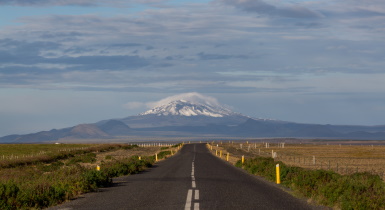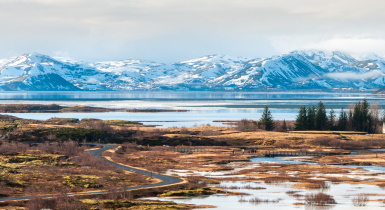Iceland’s starring attraction is its landscapes. Straddling the Eurasian and Mid-Atlantic tectonic plates, this is a land where geological processes that we think of as happening over millennia can appear almost visible to the naked eye; a land where smouldering volcanoes cast a shadow over glacial lagoons; where deep fissures in the earth, created by the meeting of the tectonic plates, give rise to spectacular mountain ridges, valleys, and lakes. These dramatic Icelandic landscapes form the setting for our guided and self-drive tours, which cover the length and breadth of the country, from its frigid coastlines to its mountainous interior.
Most of Iceland’s population live in the capital, Reykjavik, a lively city run on geothermal power and an excellent centre from where you can learn more about Iceland’s Viking history, view its famous art galleries, and check out the lively bars. From Reykjavik, a number of day excursions are available, but Iceland is best visited on a road trip or guided tour, allowing you to explore its diverse landscapes north, south and east of Reykjavik.
The country divides into seven regions including the capital, and national parks protect much of the interior and coastal places of special natural beauty. Roads are good year-round, and it is possible to tour Iceland (a typical tour lasts 5 to 9 days) at any season, though access to the country’s central highlands can be limited in winter. Northern Lights, thermal springs and lively Reykjavik attract the winter visitors. Summer, bringing longer days, is the ideal season for walking and driven tours, boat trips and for visiting the neighbouring island of Greenland.
ICELAND & GREENLAND AT A GLANCE
Iceland has a sub-Arctic climate moderated by the Gulf Stream and experiences temperatures that, while cold, are higher than you might expect for a country located within the Arctic Circle! There are four seasons with different travel opportunities for each season.
Winter means short days with great opportunities to see the Northern Lights, visit glacial lagoons, bathe in thermal springs and practice winter sports
Iceland’s short spring lasts April through May and is a great season to see the spring flora, and to visit Southern Iceland’s famous attractions such as the Golden Circle and Blue Lagoon at discounted shoulder season rates.
Summer is the best season for self-drive road trips, trekking, rafting and boat tours. It is also the best season to fly from Reykjavik to Greenland for a one to four days extension.
- Reykjavik, the world’s most northerly capital, is the only city in Iceland with a population greater than 100,000! It dominates the country’s cultural scene, and is known for its art, music, bars and restaurants.
Reykjavik is also a great base from which to book day excursions, with easy access to famous attractions such as Gullfoss, Thingvellir National Park, and the Blue Lagoon, and of course you naturally start and end your holiday to Iceland in this lively city!
- The world’s largest island, Greenland, is politically associated with Denmark but has home rule, and can be most easily visited from Iceland.
Greenland has an Arctic and sub-Arctic climate so the best season to visit is from April to September. 3 and 4 day tours to West Greenland operate through the summer months.
- From June to late August, fly-in day excursions from Iceland to the wild and colder east coast of Greenland are possible.





